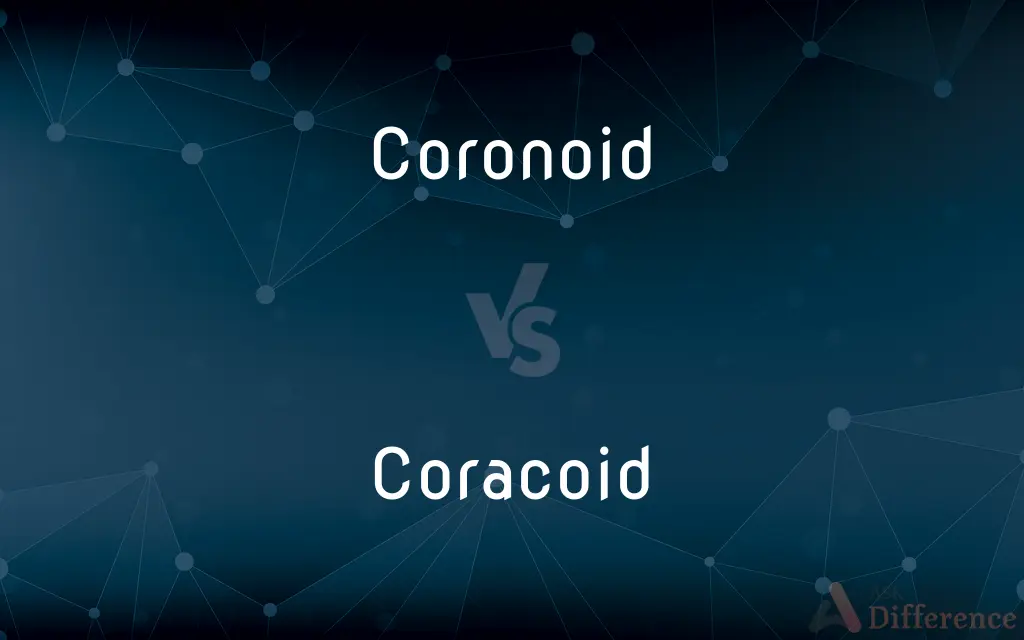Coronoid vs. Coracoid — What's the Difference?
Edited by Tayyaba Rehman — By Fiza Rafique — Updated on September 27, 2023
The coronoid is a projection on the ulna bone of the forearm. The coracoid is a bony process on the scapula (shoulder blade).

Difference Between Coronoid and Coracoid
Table of Contents
ADVERTISEMENT
Key Differences
The coronoid and coracoid are anatomical terms related to the skeletal system but refer to distinct locations. The coronoid is primarily associated with the ulna, one of the two bones in the forearm. On the other hand, the coracoid is a projection found on the scapula or shoulder blade.
In terms of function and significance, the coronoid process provides attachment for various muscles and ligaments of the forearm. It plays an essential role in forearm movements. The coracoid process, meanwhile, is crucial for the attachment of several shoulder muscles and ligaments, facilitating shoulder joint movements.
To understand the importance of the coronoid, one should look into the elbow joint's mechanics. The coronoid process of the ulna fits into the coronoid fossa of the humerus during flexion. In contrast, the coracoid process is vital in shoulder stability, as several ligaments and the biceps brachii's short head originate from it.
Differentiating between the coronoid and coracoid processes is critical for medical professionals. While the coronoid is linked to forearm and elbow function, the coracoid is instrumental in shoulder dynamics. Thus, any injury to these structures could impact respective joint mobility and function.
Comparison Chart
Location
Found on the ulna in the forearm
Located on the scapula (shoulder blade)
ADVERTISEMENT
Function
Provides attachment for forearm muscles and ligaments
Offers attachment for shoulder muscles and ligaments
Associated Joint
Elbow joint
Shoulder joint
Relation to Bones
Related to ulna and humerus
Related to scapula and clavicle
Significance
Vital in elbow joint mechanics
Essential in shoulder stability
Compare with Definitions
Coronoid
A projection on the ulna bone in the forearm.
The coronoid process is a critical site of attachment for several forearm muscles.
Coracoid
An anterior projection on the shoulder blade.
Ligaments connecting the scapula and clavicle are anchored on the coracoid.
Coronoid
The anterior projection at the top of the ulna.
During elbow flexion, the coronoid process fits into the coronoid fossa of the humerus.
Coracoid
A bony process projecting from the scapula.
The coracoid process serves as an attachment site for the biceps brachii's short head.
Coronoid
A structure vital for the hinge movement of the elbow.
Injuries to the coronoid can impede smooth elbow function.
Coracoid
A bony prominence related to shoulder movement.
Any injury to the coracoid can limit the range of shoulder movements.
Coronoid
A part of the anterior ulna.
The coronoid is palpable just below the elbow's bend.
Coracoid
A structure providing muscular attachments in the shoulder.
The pectoralis minor muscle originates from the coracoid process.
Coronoid
A bony prominence providing ligamentous attachments.
The radial collateral ligament attaches to the coronoid process.
Coracoid
A coracoid (from Greek κόραξ, koraks, raven) is a paired bone which is part of the shoulder assembly in all vertebrates except therian mammals (marsupials and placentals). In therian mammals (including humans), a coracoid process is present as part of the scapula, but this is not homologous with the coracoid bone of most other vertebrates.In other tetrapods it joins the scapula to the front end of the sternum and has a notch on the dorsal surface which, along with a similar notch on the ventral surface of the scapula, forms the socket in which the proximal end of the humerus (upper arm bone) is located.
Coronoid
(anatomy) Shaped like the beak of a crow.
Coracoid
A bony process projecting from the scapula toward the sternum in mammals.
Coronoid
(anatomy) A slender bone that forms part of the lower jaw of primitive vertebrates.
Coracoid
A beak-shaped bone articulating with the scapula and sternum in many other vertebrates, such as birds and reptiles.
Coronoid
(organic chemistry) Any polycyclic aromatic hydrocarbon derived from coronene.
Coracoid
Of, relating to, or resembling a coracoid.
Coronoid
Resembling the beak of a crow; as, the coronoid process of the jaw, or of the ulna.
Coracoid
(anatomy) Part of the scapula that projects towards the sternum in mammals; the coracoid process
Coracoid
(anatomy) A small bone linking the scapula and sternum in birds, reptiles and some other vertebrates
Coracoid
Hooked like the beak of a crow
Coracoid
Relating to the coracoid process
Coracoid
Shaped like a crow's beak.
Coracoid
Pertaining to a bone of the shoulder girdle in most birds, reptiles, and amphibians, which is reduced to a process of the scapula in most mammals.
Coracoid
The coracoid bone or process.
Coracoid
A part essential for shoulder stability.
The coracoid process prevents the upward dislocation of the arm bone.
Common Curiosities
Are the coronoid and coracoid connected?
No, the coronoid is in the forearm, while the coracoid is in the shoulder area.
What's the significance of the coracoid in shoulder stability?
The coracoid process provides anchorage for shoulder ligaments and muscles, ensuring joint stability.
How does the coracoid assist in arm elevation?
The coracoid prevents the upward dislocation of the arm bone during elevation.
What is the coronoid?
The coronoid is a projection on the ulna bone in the forearm.
What happens if the coronoid process is fractured?
A coronoid fracture can impede elbow function and might require surgical intervention.
Where is the coracoid located?
The coracoid is a bony process on the scapula or shoulder blade.
Is the coronoid related to elbow movement?
Yes, the coronoid is crucial for the hinge movement of the elbow.
Are there any specific exercises to strengthen muscles around the coracoid?
Yes, exercises like shoulder presses and push-ups can strengthen muscles around the coracoid.
What muscles attach to the coronoid?
Various forearm muscles and ligaments attach to the coronoid process.
What ligaments are associated with the coracoid?
Ligaments like the coracoclavicular and coracoacromial are associated with the coracoid process.
Which muscles originate from the coracoid?
Muscles such as the pectoralis minor and the short head of the biceps brachii originate from the coracoid.
Can you feel the coronoid?
The coronoid is palpable just below the elbow's bend.
Why is the coronoid important in forearm function?
The coronoid provides attachment sites crucial for the forearm's muscles and ligaments.
How can one differentiate between the coronoid and coracoid?
The coronoid is associated with the forearm, while the coracoid is linked to the shoulder blade.
Share Your Discovery

Previous Comparison
Nest vs. Nestle
Next Comparison
Outflux vs. EffluxAuthor Spotlight
Written by
Fiza RafiqueFiza Rafique is a skilled content writer at AskDifference.com, where she meticulously refines and enhances written pieces. Drawing from her vast editorial expertise, Fiza ensures clarity, accuracy, and precision in every article. Passionate about language, she continually seeks to elevate the quality of content for readers worldwide.
Edited by
Tayyaba RehmanTayyaba Rehman is a distinguished writer, currently serving as a primary contributor to askdifference.com. As a researcher in semantics and etymology, Tayyaba's passion for the complexity of languages and their distinctions has found a perfect home on the platform. Tayyaba delves into the intricacies of language, distinguishing between commonly confused words and phrases, thereby providing clarity for readers worldwide.
















































